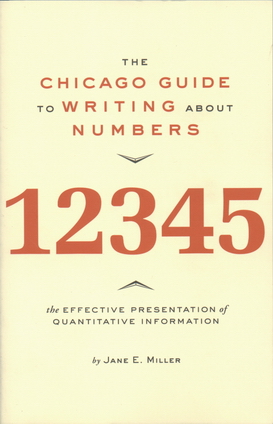

“Jane E. Miller is associate professor in the Institute for Health, Health Care Policy, and Aging Research and the Edward J. Bloustein School of Planning and Public Policy at Rutgers University. Trained as a demographer at the University of Pennsylvania, she has taught research methods and statistics for more than a decade.” — Amazon
ARTICLES (Introductory):
- Quantitative Literacy across the Curriculum: Integrating Skills from English Composition, Mathematics, and the Substantive Disciplines Paper published by Education Forum (2010)
- J.E. Miller, 2008. Contributions of Expository Writing to Numeric Communication: Guidelines for Writing up Word Problems Working paper, Rutgers University. Recommended for middle school and high school teachers.
- J.E. Miller, 2007. Organizing Data in Tables and Charts: Different Criteria for Different Tasks Teaching Statistics. 29(3):98-101.
ARTICLES (Multivariate):
- J.E. Miller (2013). Getting to know your variables: A critical element of a statistical analysis ASA Montreal 1up 6up Audio
- J.E. Miller and L. Wu. 2009. Teaching How to Write about Multivariate Analysis: Suggested Courses and Exercises Working paper, Rutgers Univ.
- J.E. Miller, 2008. Interpreting the Substantive Significance of Regression Coefficients Proceedings of the ASA Statistical Education Section. 1up
- J.E. Miller and Y.V. Rodgers, 2008. Economic Importance and Statistical Significance: Guidelines for Communicating Empirical Research Feminist Economics. 14(2): 117-149.
- J.E. Miller, 2008. The Goldilocks Principle: Avoiding Pitfalls in Interpretation of Regression Coefficients Social Science Research Network eLibrary.
- J.E. Miller, 2008. Writing about Hazards Models: Practical Guidelines for Effective Presentation Working paper, Rutgers University; version with examples from medicine and public health.
- J.E. Miller, 2008. Writing about Hazards Models: Practical Guidelines for Effective Presentation Working paper, Rutgers University;version with examples from economics.
BOOKS:
The Chicago Guide to Writing About Numbers (2004)
 Paperback: 312 pages. Publisher: University Of Chicago Press; 1 edition (November 3, 2004)
Study guide
Paperback: 312 pages. Publisher: University Of Chicago Press; 1 edition (November 3, 2004)
Study guide
Book Description:
People who work well with numbers are often stymied by how to write about them. Those who don't often work with numbers have an even tougher time trying to put them into words. For instance, scientists and policy analysts learn to calculate and interpret numbers, but not how to explain them to a general audience. Students learn about gathering data and using statistical techniques, but not how to write about their results. And readers struggling to make sense of numerical information are often left confused by poor explanations. Many books elucidate the art of writing, but books on writing about numbers are nonexistent.
Until now. Here, Jane Miller, an experienced research methods and statistics teacher, gives writers the assistance they need. The Chicago Guide to Writing about Numbers helps bridge the gap between good quantitative analysis and good expository writing. Field-tested with students and professionals alike, this book shows writers how to think about numbers during the writing process.
Miller begins with twelve principles that lay the foundation for good writing about numbers. Conveyed with real-world examples, these principles help writers assess and evaluate the best strategy for representing numbers. She next discusses the fundamental tools for presenting numbers—tables, charts, examples, and analogies—and shows how to use these tools within the framework of the twelve principles to organize and write a complete paper.
By providing basic guidelines for successfully using numbers in prose, The Chicago Guide to Writing about Numbers will help writers of all kinds clearly and effectively tell a story with numbers as evidence. Readers and writers everywhere will be grateful for this much-needed mentor.
Table of Contents:
- Why Write About Numbers?
-
PRINCIPLES
- Seven Basic Principles
- Causality, Statistical Significance and Substantive Significance
- Technical but Important: Five More Technical Principles
-
TOOLS
- Types of Quantitative Comparisons
- Creating Effective Tables
- Creating Effective Charts
- Choosing Effective Examples and Analogies.
-
PULLING IT ALL TOGETHER
- Writing about Distributions and Associations
- Writing About Data and Methods
- Writing Introductions, Results and Conclusions
- Speaking about Numbers.
Appendix A: Implementing Generalization, Example and Exceptions (GEE)
Reviews:
Joel Best: “A most original work—a how-to guide for just about anyone trying to write (or talk) about numeric data. Miller's is a mentor's voice.”
Milo Schield: “Highly recommended. The Chicago Guide to Writing About Numbers addresses core issues in statistical literacy and is a must-read for journalists, advocacy writers and policy analysts.”
Neil Lutsky,
Review in Numeracy:
Abstract: “The Chicago Guide to Writing About Numbers is
a reference work suitable for anyone interested in understanding, using, or
promoting quantitative thinking. Its primary aim is to identify and
illustrate ways in which information associated with numbers can be conveyed
most effectively given a particular communication purpose and context. The
book is directed at writers who incorporate numbers in verbal or visual
displays in documents, in oral presentations, or on the Web. The Chicago
Guide to Writing about Numbers identifies overarching principles, offers
concrete advice, and presents illuminating examples and models. The book can
be used for instructional purposes for undergraduates, and a means of doing
so is described. The review concludes by considering the book’s
contributions to a wider call to help citizens write or argue more
effectively by using numbers.”
Article: “from a broader perspective
the book is about writing or arguing more effectively by using numbers.
Doing so sets quantitative reasoning in the context of rhetoric or
argument. …”
The Chicago Guide to Writing About Multivariate Analysis
 Paperback: 424 pages. Publisher: University Of Chicago Press (1st ed. August 1, 2005)
Study guide
Paperback: 424 pages. Publisher: University Of Chicago Press (1st ed. August 1, 2005)
Study guide
Second edition. Univ. Chicago website. For the second edition of The Chicago Guide to Writing about Multivariate Analysis, Miller has created materials for an extensive supplementary website for students and instructors, which includes slide shows, spreadsheet templates, and podcasts to illustrate the concepts and techniques of the book. Also online is a study guide, of problem sets, solutions, and suggested course extensions and suggestions for instructors on how to teach the material in formal courses as well as informal settings
Book Description:
Writing about multivariate analysis is a surprisingly common task. Researchers use these advanced statistical techniques to examine relationships among multiple variables, such as exercise, diet, and heart disease, or to forecast information such as future interest rates or unemployment. Many different people, from social scientists to government agencies to business professionals, depend on the results of multivariate models to inform their decisions. At the same time, many researchers have trouble communicating the purpose and findings of these models. Too often, explanations become bogged down in statistical jargon and technical details, and audiences are left struggling to make sense of both the numbers and their interpretation.
Here, Jane Miller offers much-needed help to academic researchers as well as to analysts who write for general audiences. The Chicago Guide to Writing about Multivariate Analysis brings together advanced statistical methods with good expository writing. Starting with twelve core principles for writing about numbers, Miller goes on to discuss how to use tables, charts, examples, and analogies to write a clear, compelling argument using multivariate results as evidence.
Writers will repeatedly look to this book for guidance on how to express their ideas in scientific papers, grant proposals, speeches, issue briefs, chartbooks, posters, and other documents. Communicating with multivariate models need never appear so complicated again.
Table of Contents:
- Introduction
-
PRINCIPLES
- Seven Basic Principles
- Causality, Statistical Significance and Substantive Significance
- Five More Technical Principles
-
TOOLS
- Creating More Effective Tables
- Creating More Effective Charts
- Choosing Effective Examples and Analogies
- Basic Types of Quantitative Comparisons
- Quantitative Comparisons for Multivariate Models
- Choosing How to Present Statistical Test Results.
-
PULLING IT ALL TOGETHER
- Writing Introductions, Conclusions and Abstracts
- Writing About Data and Methods
- Writing about Distributions and Associations
- Writing about Multivariate Models
- Writing about Multivariate Analyses
- Writing for Applied Audiences
Appendix A: Implementing Generalization, Example and Exceptions (GEE).
Appendix B: Translating Statistical Output into Table and Text.

